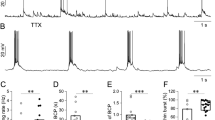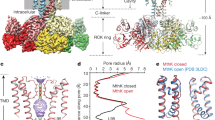Abstract
Calcium channels in excitable membranes are essential for many cellular functions. Recent analyses of the burst-firing mode of some vertebrate neurones1–3 suggest that changes in their functional state are controlled by a Ca conductance that is largely inactivated at resting membrane potentials (−50 to −60 mV), but becomes activated following a conditioning hyperpolarization of the cell membrane. Here, using chick and rat sensory neurones, we present evidence for a new type of Ca channel with time- and voltage-dependent properties which is probably responsible for the inactivation behaviour of the Ca conductance. At membrane potentials between −50 and +10 mV, openings of this channel last 3–6 ms and tend to occur in rapid succession. Inactivation of this channel is indicated by prolonged and eventually complete closures brought about by long-lasting depolarizing voltage steps. This channel coexists in isolated membrane patches with the more common Ca channel4 which is less sensitive to changes in holding potential and shows a considerably shorter average life time and smaller currents.
This is a preview of subscription content, access via your institution
Access options
Subscribe to this journal
Receive 51 print issues and online access
$199.00 per year
only $3.90 per issue
Buy this article
- Purchase on Springer Link
- Instant access to full article PDF
Prices may be subject to local taxes which are calculated during checkout
Similar content being viewed by others
References
Llinas, R. & Yarom, Y. J. Physiol., Lond. 315, 569–584 (1981).
Llinas, R. & Jahnsen, H. Nature 297, 406–408 (1982).
Jahnsen, H. & Llinas, R. J. Physiol., Lond. 349, 205–226 (1984).
Brown, A. M., Camerer, H., Kunze, D. L. & Lux, H. D. Nature 299, 156–158 (1982).
Barde, Y. A., Edgar, D. & Thoenen, H. Proc. natn. Acad. Sci. U.S.A. 77, 1199–1203 (1980).
Horn, R. & Patlak, J. B. Proc. natn. Acad. Sci. U.S.A. 77, 6930–6934 (1980).
Hamill, O. P. & Sakmann, B. J. Physiol., Lond. 312, 41P–42P (1981).
Hamill, O. P., Marty, A., Neher, E., Sakmann, B. & Sigworth, E. F. J. Pflügers Arch. ges. Physiol. 391, 85–100 (1981).
Carbone, E. & Lux, H. D. Biophys. J. (in the press).
Fenwick, E. M., Marty, A. & Neher, E. J. Physiol., Lond. 331, 599–635 (1982).
Adams, D. J. & Gage, P. W. J. Physiol., London. 291, 467–481 (1979).
Lux, H. D. & Brown, A. M. J. gen. Physiol. 83, 727–750 (1984).
Hagiwara, S. & Byerly, L. A. Rev. Neurosci. 4, 69–125 (1981).
Lux, H. D. in Single-Channel Recording (eds Sakmann, B. & Neher, E.) 437–449 (Plenum, New York, 1983).
Nagy, K., Kiss, T. & Hof, D. Pflügers Arch ges. Physiol. 399, 302–308 (1983).
Hagiwara, S., Ozawa, S. & Sand, O. J. gen. Physiol. 65, 617–644 (1975).
Author information
Authors and Affiliations
Rights and permissions
About this article
Cite this article
Carbone, E., Lux, H. A low voltage-activated, fully inactivating Ca channel in vertebrate sensory neurones. Nature 310, 501–502 (1984). https://doi.org/10.1038/310501a0
Received:
Accepted:
Issue Date:
DOI: https://doi.org/10.1038/310501a0
This article is cited by
-
Central and peripheral contributions of T-type calcium channels in pain
Molecular Brain (2022)
-
Skeletal Functions of Voltage Sensitive Calcium Channels
Current Osteoporosis Reports (2021)
-
Giant Y79 retinoblastoma cells contain functionally active T-type calcium channels
Pflügers Archiv - European Journal of Physiology (2021)
-
Presynaptic calcium channels: specialized control of synaptic neurotransmitter release
Nature Reviews Neuroscience (2020)
-
Smartphone-powered efficient water disinfection at the point of use
npj Clean Water (2020)
Comments
By submitting a comment you agree to abide by our Terms and Community Guidelines. If you find something abusive or that does not comply with our terms or guidelines please flag it as inappropriate.



